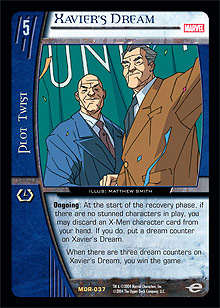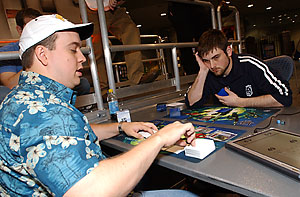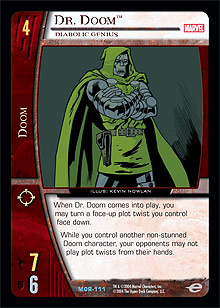
Today, I’m going to walk you through what’s necessary to build a combo deck. This topic is probably my most difficult one to tackle yet. This is mainly due to the fact that only two real combo decks have shown up in premier-level play (three if you count the Captain Marvel, Champion of Magic variants). However, being part of the group that was responsible for one (Xavier’s Dream) and being a teammate of someone who has Top 8’d with another (Rigged Elections), I feel that I should be adequately equipped to take you on this journey.
HERE IT IS, IN ALL ITS GLORY . . .
I never thought I would see the day when someone would be criticizing my directorial abilities. This is due, in no small part, to the fact that I never anticipated directing a video . . . ever. However, I received that criticism as I walked into my local card shop over the weekend. Someone told me I didn’t know how to hold the camera steady and I was quite loud (apparently, the director can’t talk). I was confused at first. Then he told me that I needed to think of a better title than “Dr. Light Brings Aqualad into Play.” It immediately clicked. If you read my articles, you will remember when I first told you about the craziness that was the oversized Dr. Light, Master of Holograms bringing Tim Batow into play. Well, John Hall, the man behind those cool shirts we wore at Pro Circuit San Francisco, put up the video on YouTube. Do some searches to find it, in all its funny and strange glory.
DOUBLE-EDGED SWORD
 Why—or why not for that matter—are combo decks popular? Often times they are frowned upon, but I believe this is generally because they win in a manner that is not conventional. After Pro Circuit New York, at many local shops, I know that players were cursing Xavier’s Dream. My shop was one of them. I remember a player refusing to play me, going so far as to even take a forfeit. I asked him why he didn’t want to play, and he looked at me blankly, saying that it’s not playing. I asked him what he meant. He said that combo decks didn’t care what your opponent did, or worse, completely limited your opponent from doing anything at all. In many instances, that is true. In most combo decks, the goal of the deck is to maintain total control until you can spring out your win condition.
Why—or why not for that matter—are combo decks popular? Often times they are frowned upon, but I believe this is generally because they win in a manner that is not conventional. After Pro Circuit New York, at many local shops, I know that players were cursing Xavier’s Dream. My shop was one of them. I remember a player refusing to play me, going so far as to even take a forfeit. I asked him why he didn’t want to play, and he looked at me blankly, saying that it’s not playing. I asked him what he meant. He said that combo decks didn’t care what your opponent did, or worse, completely limited your opponent from doing anything at all. In many instances, that is true. In most combo decks, the goal of the deck is to maintain total control until you can spring out your win condition.
So, why play a deck that frustrates your opponent? Well, to be honest, sometimes running characters into each other gets boring. I know there are some purists who play the game solely to team-up Dr. Doom and The Joker for the ultimate bad guy party, but when you try to look at the game competitively, sometimes you long for more. That’s what a combo deck can provide. It gives you the opportunity to play a deck that not only requires a high level of thinking, but also rewards hours of diligent testing and practicing with hard-earned wins. This is why combo decks are fun. They are a challenge. They are that unattainable mountaintop that many want to climb, but few are able. Well, I am here to tell you today that the journey can be made, and it can be made with success!
CAN DREAMS BECOME A REALITY?
 I figured the best way to describe how to build a successful combo deck would be to take you through the building process of a deck that gained my team some notoriety and one of our first PC Top 8 performances. This deck was essentially the brainchild of Tim Batow and Michael Barnes. At first, everyone dismissed the deck. It’s almost a knee-jerk reaction to every alternative win card. Phrases like “not possible,” “too difficult,” or “not worth the effort” also seem to permeate a room when you start a conversation on this topic. I am not really certain why we respond this way, but we do. I know I did. I remember thinking, “Are you crazy?” At this time in Vs. System history, every deck was combat-oriented—it was the era of Curve Sentinels and Teen Titans—so a deck that did not attack and didn’t even bother to put up a defense seemed foreign to me. However, I quickly learned to read cards more carefully when I actually played against the deck.
I figured the best way to describe how to build a successful combo deck would be to take you through the building process of a deck that gained my team some notoriety and one of our first PC Top 8 performances. This deck was essentially the brainchild of Tim Batow and Michael Barnes. At first, everyone dismissed the deck. It’s almost a knee-jerk reaction to every alternative win card. Phrases like “not possible,” “too difficult,” or “not worth the effort” also seem to permeate a room when you start a conversation on this topic. I am not really certain why we respond this way, but we do. I know I did. I remember thinking, “Are you crazy?” At this time in Vs. System history, every deck was combat-oriented—it was the era of Curve Sentinels and Teen Titans—so a deck that did not attack and didn’t even bother to put up a defense seemed foreign to me. However, I quickly learned to read cards more carefully when I actually played against the deck.
SO, HOW DO YOU DO IT?
As with many alternative win cards, there is a cost involved, and generally that cost is rather high and sometimes seemingly unattainable. Regarding Xavier’s Dream, in order to get the combo working, there could be no stunned characters in play at the start of recovery. You must do this for three turns, preferably consecutively. This concept is daunting to say the least. How in the world do you fulfill this requirement and still live to see the card do its magic? Is it even possible?
Seeing that Xavier’s Dream required an X-Men discard for it to work, and the fact that X-Men sported some of the best recovery routes, I immediately thought a straight X-Men deck could be used to make the combo great. Unfortunately, this mindset didn’t work, because a single team just doesn’t have every tool necessary to fulfill an alternate win condition deck. It’s somewhat humorous to me that team-stamped alternate win cards like Xavier’s Dream, Rigged Elections, and Captain Marvel, Champion of Magic all require a team-up with other teams to be successful.
 What were the biggest issues when trying to build Xavier’s Dream? Well, first and foremost, you needed to get Xavier’s Dream online. This meant you needed a reliable search card, and no one was better than Alfred Pennyworth. By including the faithful servant, the deck all of a sudden could support important cards like Bat-Signal, Fizzle, and GCPD Officers. These all provided much-needed abilities—such as character search, control, and reinforcement tricks—but there were still a couple of problems: how do you survive until turn 5, and how do you deal with lingering characters that would become stunned on your field? The answers were relatively simple. Total Anarchy answered one problem. Also, it was randomly searchable with Alfred Pennyworth, so it was definitely in. The next inclusion was self-explanatory, and that was Beast, Dr. Henry McCoy.
What were the biggest issues when trying to build Xavier’s Dream? Well, first and foremost, you needed to get Xavier’s Dream online. This meant you needed a reliable search card, and no one was better than Alfred Pennyworth. By including the faithful servant, the deck all of a sudden could support important cards like Bat-Signal, Fizzle, and GCPD Officers. These all provided much-needed abilities—such as character search, control, and reinforcement tricks—but there were still a couple of problems: how do you survive until turn 5, and how do you deal with lingering characters that would become stunned on your field? The answers were relatively simple. Total Anarchy answered one problem. Also, it was randomly searchable with Alfred Pennyworth, so it was definitely in. The next inclusion was self-explanatory, and that was Beast, Dr. Henry McCoy.
At this point, the win condition was viable. There was adequate search, and there was a contingency plan to meet the requirements of the card in question. The same strategy that was employed above was converted over to Rigged Elections. That deck utilizes character search cards (Bat-Signal and Wild Ride) as well as plot twist search (with the aforementioned Alfred Pennyworth) to set up its board.
SO, YOU HAVE THE CONCEPT; HOW DO YOU EXECUTE IT?
In regards to Xavier’s Dream, this part was easy. With Curve Sentinels and Teen Titans everywhere, it was really easy to facilitate a game plan. The question then becomes, how do you come up with a game plan?
In order to determine a plan of action to execute your combo, you need to identify your deck’s weaknesses and then turn them into situations that you can deal with. When we did this with Xavier’s Dream, the biggest issues were surviving until turn 6 in order to win through our combo and keeping stunned characters off the board. Unfortunately, there were no cards that really recovered your opponent’s characters, so we were forced to look elsewhere. Also, if we recovered our opponent’s characters, it would just mean that they would have more attackers, and we obviously didn’t want that. So, naturally we turned to KO effects. Finishing Move was the KO effect of choice at the time. It was employed in several decks and was very efficient, with the only cost being exhausting a character. However, often times, with Total Anarchy on the field, we would not have that character to exhaust, so we had to go to the less effective Death in the Family. I say “less effective” for the reason that the endurance had to be paid in addition to the cost, which sometimes made it unplayable late. Nevertheless, that answered the question of getting rid of the opponent’s stunned characters . . . but what about lessening some of the damage we would take? Well, Pleasant Distraction worked nicely for this. Granted, it offered no protection on your opponent’s initiative, but it was great on yours.
What about other combo decks? Well, as in the analysis above, you need to look for what your combo deck is weak against. For Rigged Elections, it is generally plot twist disruption (cards like Foiled or Have a Blast!) or cards that can eliminate your board (such as Flame Trap or Reign of Terror). In regards to Secret Six Victorious, KO effects can be really problematic. Also, any card that would increase the threshold cost of your win condition—such as Bad Press or Sage, Xavier’s Secret Weapon—would be a very bad thing.
METAGAMES AGAIN?
I know, I know . . . how many times will I mention this? Well, to be honest, a lot. I learn best through repetition, and at worst, maybe in your deckbuilding exploits, you will remember skimming my articles and thinking, “Jeez, enough about metagames,” and then you will remember to build your deck accordingly.
When Xavier’s Dream was pretty much built, it went into a gauntlet. However, we knew from the get-go that we would have good results. It was an auto-win against Curve Sentinels. They could only stun characters of their own by using the since-banned Overload/Nasty Surprise/Savage Beatdown combo, and in that matchup, we would just save a Fizzle to stop it from happening.
Teen Titans was much more problematic. They had many ways to stun their own characters with Roy Harper ◊ Arsenal, Sharpshooter, not to mention packing plot twist hate like Foiled and/or Have a Blast!. In the end, we figured we would take a 50/50 matchup here because we felt that Curve Sentinels would more than make up for any losses we would take against Teen Titans.
Taking what I just discussed above, the best thing to do when trying to figure out how successful your deck will be is to look at what you expect to see, and then determine if those matchups present an environment that your combo deck can thrive in. Unfortunately, this won’t always be the case, as you will see below.
TIMING
 One of the most frustrating things about combo decks is not being able to play them. People at my local shop had randomly been trying to break Xavier’s Dream since Vs. System first debuted. Unfortunately, the randomness of what was being played kept it from being able to perform. Often times, Common Enemy decks and Dr. Doom, Diabolic Genius would be too much for Dream to handle, so there was never a good time to introduce it. But after Curve Sentinels started putting the smack down on the good doctor, the timing started to look better. We managed to strike when the time was right, and my teammate Michael Barnes finished Day 1 with an impressive 11-1 record. However, we have not played the deck in a premier-level event since then because the conditions haven’t been right.
One of the most frustrating things about combo decks is not being able to play them. People at my local shop had randomly been trying to break Xavier’s Dream since Vs. System first debuted. Unfortunately, the randomness of what was being played kept it from being able to perform. Often times, Common Enemy decks and Dr. Doom, Diabolic Genius would be too much for Dream to handle, so there was never a good time to introduce it. But after Curve Sentinels started putting the smack down on the good doctor, the timing started to look better. We managed to strike when the time was right, and my teammate Michael Barnes finished Day 1 with an impressive 11-1 record. However, we have not played the deck in a premier-level event since then because the conditions haven’t been right.
Speaking in generalities, most combo decks require an intense knowledge of the upcoming metagame. This is because combo decks are very fragile; they are built on one specific card most times, and any deck that plays any type of disruption can cause massive headaches. Determining what will be played can tip you off as to whether your deck can even succeed, but you never REALLY know what is going to show up. (For more information on this, check out my previous article.)
Some theoretical questions you could ask yourself: Will there be too many KO effects to allow me to give my Secret Six Victorious deck a shot? Can my burn deck that focuses on a couple key cards survive the potential hate out there? Is it possible to stall to turn 10 and plop down Mageddon? I don’t really know the answers to these questions.
If you aspire to build a combo deck, you need to continue to test and build other decks for the format. Too many times, individuals will become focused on a deck so much that they may miss a better, more conventional deck. You must keep your mind open when building and continually look for the top versions of what you expect to show up as well as new stuff that other individuals may discover.
IN THE END
So, what have we learned through this article? We learned that a lot of thought and hard work go into combo decks. These decks really are a lot of fun to play, but I don’t think they would work well in Hobby Leagues. I am of the opinion that Hobby Leagues are for casual play, and as stated previously, many of the decks I have been trying to help you build completely eliminate your opponent’s options. Don’t get me wrong—combo decks are a blast to play—but as I also said, you have to consider the timing. Hopefully, I was able to aid you in the thought process that goes into building a combo deck, and if you have any questions, you can feel free to contact me at piercedlawyer@yahoo.com.